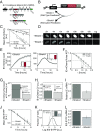Feedback-mediated signal conversion promotes viral fitness
- PMID: 30150412
- PMCID: PMC6140503
- DOI: 10.1073/pnas.1802905115
Feedback-mediated signal conversion promotes viral fitness
Abstract
A fundamental signal-processing problem is how biological systems maintain phenotypic states (i.e., canalization) long after degradation of initial catalyst signals. For example, to efficiently replicate, herpesviruses (e.g., human cytomegalovirus, HCMV) rapidly counteract cell-mediated silencing using transactivators packaged in the tegument of the infecting virion particle. However, the activity of these tegument transactivators is inherently transient-they undergo immediate proteolysis but delayed synthesis-and how transient activation sustains lytic viral gene expression despite cell-mediated silencing is unclear. By constructing a two-color, conditional-feedback HCMV mutant, we find that positive feedback in HCMV's immediate-early 1 (IE1) protein is of sufficient strength to sustain HCMV lytic expression. Single-cell time-lapse imaging and mathematical modeling show that IE1 positive feedback converts transient transactivation signals from tegument pp71 proteins into sustained lytic expression, which is obligate for efficient viral replication, whereas attenuating feedback decreases fitness by promoting a reversible silenced state. Together, these results identify a regulatory mechanism enabling herpesviruses to sustain expression despite transient activation signals-akin to early electronic transistors-and expose a potential target for therapeutic intervention.
Keywords: feedback circuitry; mathematical model; single-cell imaging; virus.
Conflict of interest statement
The authors declare no conflict of interest.
Figures




Similar articles
-
Human Cytomegalovirus Utilizes Multiple Viral Proteins to Regulate the Basement Membrane Protein Nidogen 1.J Virol. 2022 Oct 26;96(20):e0133622. doi: 10.1128/jvi.01336-22. Epub 2022 Oct 11. J Virol. 2022. PMID: 36218358 Free PMC article.
-
General blockade of human cytomegalovirus immediate-early mRNA expression in the S/G2 phase by a nuclear, Daxx- and PML-independent mechanism.J Gen Virol. 2011 Dec;92(Pt 12):2757-2769. doi: 10.1099/vir.0.034173-0. Epub 2011 Aug 10. J Gen Virol. 2011. PMID: 21832009
-
Disruption of PML-associated nuclear bodies by IE1 correlates with efficient early stages of viral gene expression and DNA replication in human cytomegalovirus infection.Virology. 2000 Aug 15;274(1):39-55. doi: 10.1006/viro.2000.0448. Virology. 2000. PMID: 10936087
-
US28: HCMV's Swiss Army Knife.Viruses. 2018 Aug 20;10(8):445. doi: 10.3390/v10080445. Viruses. 2018. PMID: 30127279 Free PMC article. Review.
-
Intrinsic Immune Mechanisms Restricting Human Cytomegalovirus Replication.Viruses. 2021 Jan 26;13(2):179. doi: 10.3390/v13020179. Viruses. 2021. PMID: 33530304 Free PMC article. Review.
Cited by
-
pH Feedback Lifecycles Programmed by Enzymatic Logic Gates Using Common Foods as Fuels.Angew Chem Int Ed Engl. 2021 May 10;60(20):11398-11405. doi: 10.1002/anie.202017003. Epub 2021 Apr 7. Angew Chem Int Ed Engl. 2021. PMID: 33682231 Free PMC article.
-
A Tale of Usurpation and Subversion: SUMO-Dependent Integrity of Promyelocytic Leukemia Nuclear Bodies at the Crossroad of Infection and Immunity.Front Cell Dev Biol. 2021 Aug 27;9:696234. doi: 10.3389/fcell.2021.696234. eCollection 2021. Front Cell Dev Biol. 2021. PMID: 34513832 Free PMC article. Review.
-
Computational modeling of protracted HCMV replication using genome substrates and protein temporal profiles.Proc Natl Acad Sci U S A. 2022 Aug 30;119(35):e2201787119. doi: 10.1073/pnas.2201787119. Epub 2022 Aug 22. Proc Natl Acad Sci U S A. 2022. PMID: 35994667 Free PMC article.
-
Bright and Early: Inhibiting Human Cytomegalovirus by Targeting Major Immediate-Early Gene Expression or Protein Function.Viruses. 2020 Jan 16;12(1):110. doi: 10.3390/v12010110. Viruses. 2020. PMID: 31963209 Free PMC article. Review.
-
Specific RNA structures in the 5' untranslated region of the human cytomegalovirus major immediate early transcript are critical for efficient virus replication.mBio. 2024 Feb 14;15(2):e0262123. doi: 10.1128/mbio.02621-23. Epub 2024 Jan 2. mBio. 2024. PMID: 38165154 Free PMC article.
References
-
- Bardeen J, Brattain WH. The transistor, a semi-conductor triode. Phys Rev. 1948;74:230–231.
-
- Becker JA, Shive JN. The transistor–A new semiconductor amplifier. Electr Eng. 1949;68:215–221.
-
- Waddington CH. Canalization of development and the inheritance of acquired characters. Nature. 1942;150:563–565. - PubMed
-
- Monod J, Jacob F. Teleonomic mechanisms in cellular metabolism, growth, and differentiation. Cold Spring Harb Symp Quant Biol. 1961;26:389–401. - PubMed
-
- Ferrell JE., Jr Self-perpetuating states in signal transduction: Positive feedback, double-negative feedback and bistability. Curr Opin Cell Biol. 2002;14:140–148. - PubMed
Publication types
MeSH terms
Substances
Grants and funding
LinkOut - more resources
Full Text Sources
Other Literature Sources

